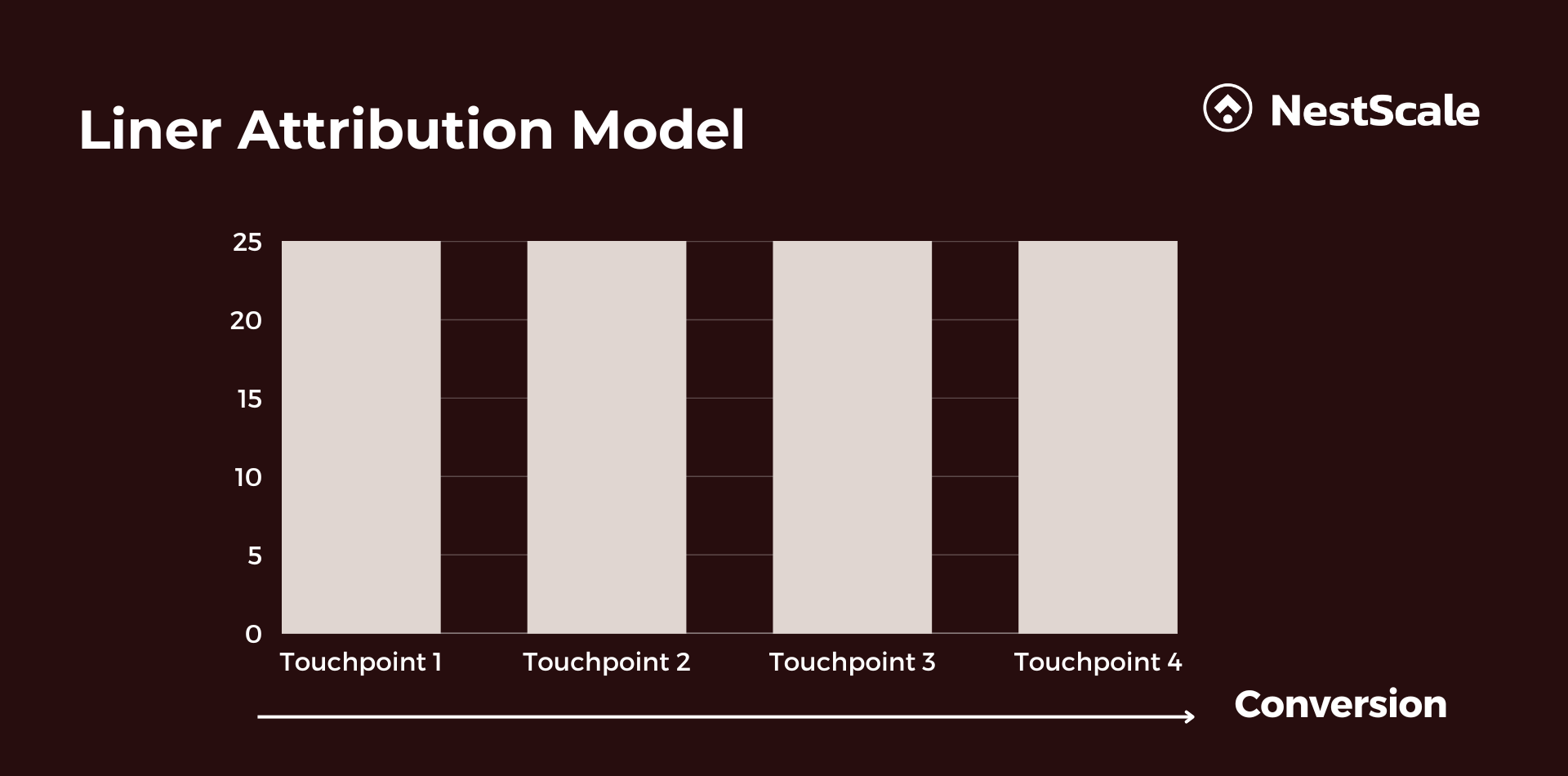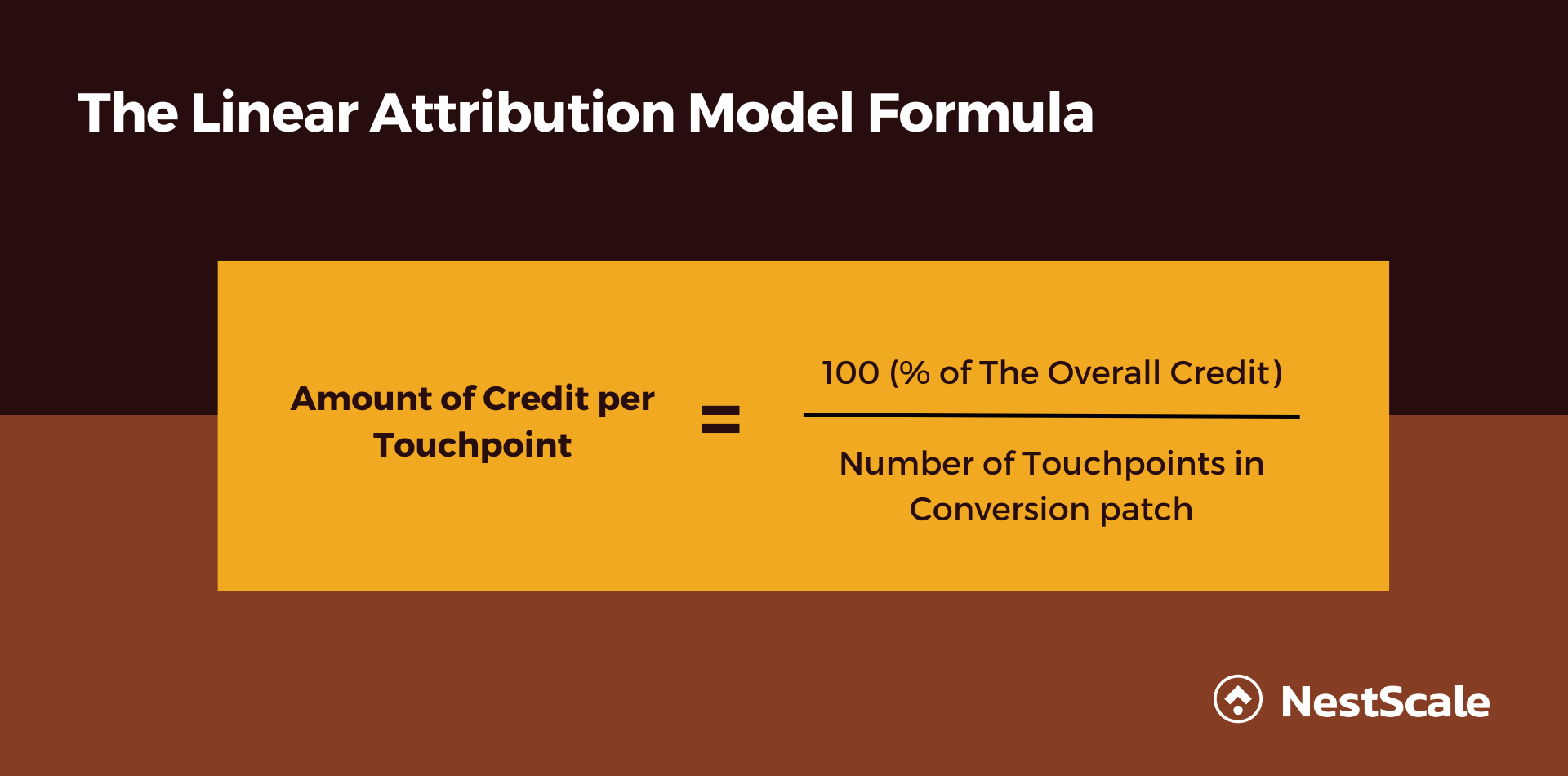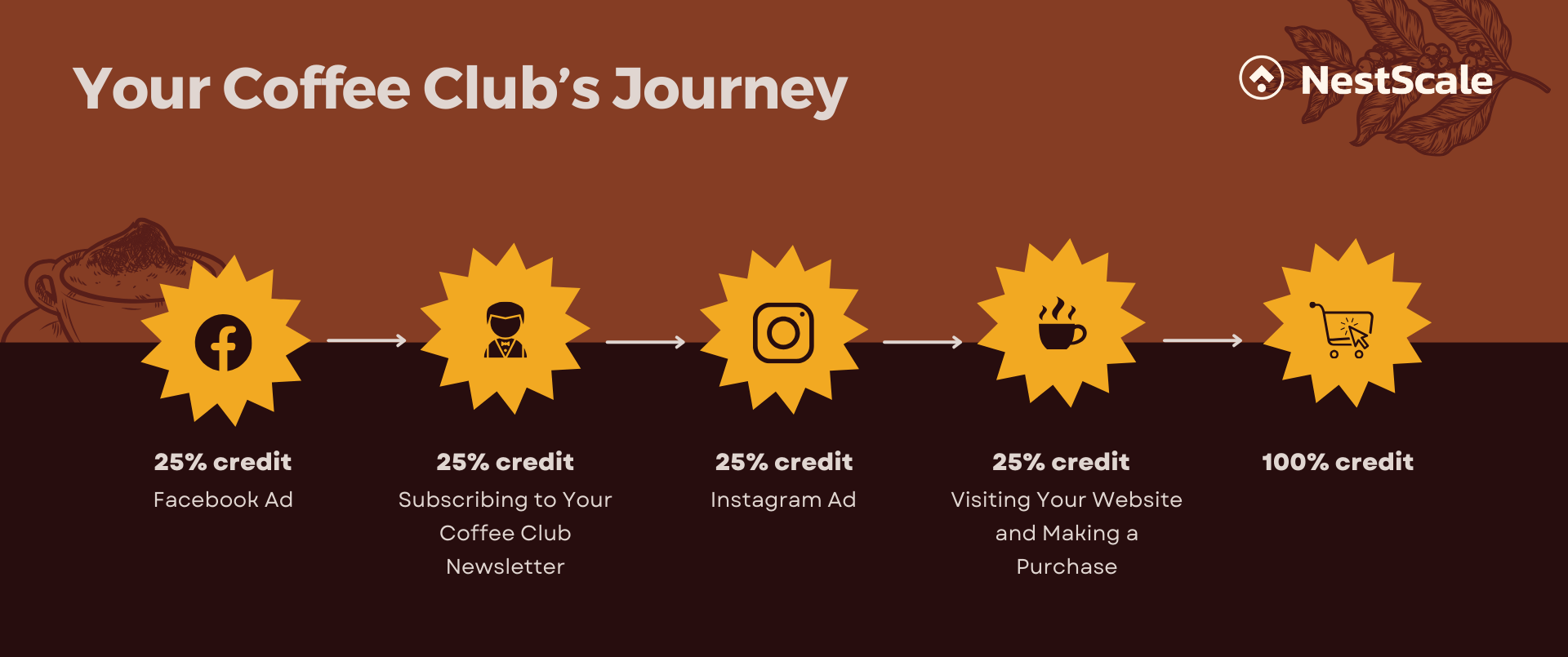In the world of digital marketing, understanding marketing attribution is crucial. It helps businesses figure out what’s causing people to buy their products or services. One of the ways to do this is by using the linear attribution model.
This guide will explain why the linear attribution model is important and how it works, including how to calculate the credit when we should use it, and provide some examples. Let’s get started!
What is a linear attribution model?
A linear attribution model is a method used in marketing to give credit to multiple touchpoints equally in the customer journey. It considers every interaction a prospect has with your brand before they make a purchase. In a mathematical way, this model is the most simple one, among the various marketing attribution models.

How does the linear attribution model calculate credit?
In a linear attribution model, each touchpoint is given equal credit in order to measure this, we use a straightforward formula:

Here, ‘100 (% of The Overall Credit)’ represents the total credit that we’re distributing among all the touchpoints, and ‘Number of Touchpoints in Conversion patch’ tells us how many steps or interactions occurred in the customer journey. This formula is all about fairness in attribution. It divides the total credit (100%) equally among all the touchpoints in the conversion path.
So, if a customer goes through, let’s say, 4 interactions before making a purchase, each of those 4 interactions would receive an equal share of 25% of the overall credit. This makes it easy to understand and implement in your marketing strategy because it ensures that credit is distributed evenly among all the touchpoints that contributed to the conversion.
How does the linear attribution model work in real-life examples?
Picture yourself running an online gourmet coffee shop in order to reach a global audience, you’ve wisely invested in Facebook advertising, a platform renowned for its extensive user base. However, simply running ads isn’t enough; you need to understand how different touchpoints contribute to your sales. This is where the concept of a linear attribution model comes into play.
Let’s illustrate the power of a linear attribution model with a hypothetical scenario. Imagine a coffee enthusiast scrolling through their Facebook feed and stumbling upon one of your enticing ads. This ad sparks their curiosity, leading them to click on it and explore your online gourmet coffee shop.

Step 1: Facebook ad (25% credit)
It begins with the Facebook ad, which initially captures their attention. In the linear
Step 2: Subscribing to your coffee club newsletter (25% credit)
Rather than making an immediate purchase, they decide to subscribe to your coffee club newsletter. They hope to stay informed about new brews and exclusive deals. This subscription step is equally valuable and is assigned 20% credit.
Step 3: Instagram ad (25% credit)
Over the following months, they regularly see your coffee club Instagram Ad, even if they don’t click into them. This ongoing engagement, too, plays a significant role in the eventual sale and is credited with 20%.
Step 4: Visiting your website and making a purchase (25% credit)
One day, a special promotion catches their eye in one of your emails. This prompts them to revisit your website and indulge in a selection of your finest coffee beans. The final step in their journey contributes 25% credit.
Now, let’s say their coffee order totals $60. With the linear attribution model, each of these touchpoints receives $20 in credit for the successful sale of those delightful coffee beans. This method ensures that every interaction in the customer’s path is equally recognized for its contribution.
You also can walk through some short customer journeys below:
Customer A:
- Receives an email newsletter from your company and clicks a link inside
- Visits your website and explores your products
- Adds an item to the cart but doesn’t make a purchase
- A few days later, sees a retargeting ad on Instagram and decides to complete the purchase
In this journey, there are 4 touchpoints. The linear attribution model divides the credit equally among them, so each touchpoint gets 25% credit for the sale.
Customer B:
- Comes across your YouTube video showcasing your product
- After watching the video, clicks on a link in the video description to visit your website
- Navigates around your site, checking out different product pages
- Leaves the site but later receives a promotional email from your company
- Clicks the email link and makes a purchase
In this journey, there are 5 touchpoints. With the linear attribution model, each touchpoint gets an equal share of the credit, so each one receives 20% credit for the sale.
Pros and cons of the linear attribution model?
The linear attribution model offers several key advantages compared with other multi-touch models that you need to notice.
| Pros | Cons |
| Comprehensive understanding The linear attribution model provides a full view of the customer journey by equally crediting each touchpoint, showing how all interactions contribute to your business’s success. | Simplicity conundrum While straightforward, this lack of depth can result in basic and potentially inaccurate attribution of success, as it doesn’t explore other attribution methods. |
| User-friendly and accessible Unlike more complex models that require advanced data skills, it equally credits each touchpoint—such as a Google ad, website visit, newsletter signup, or email—making it accessible for marketers of all levels | Equal weights, unequal impact The linear model gives equal credit to all customer interactions. This approach can misallocate marketing resources, as some touchpoints may have a greater impact on the final decision. |
| No need for data science expertise This model is simple and doesn’t need advanced data science skills, allowing you to apply it without the need for complex data analysis or a team of data scientists. | Difficulty tracking across channels The linear model may have difficulty tracking across multiple platforms, leading to gaps in understanding the customer’s journey. This can affect the accuracy of your results and make it harder to optimize your marketing efforts. |
| Effective budget allocation The linear attribution model helps you allocate your marketing budget more effectively, ensuring a balanced strategy that addresses every stage of the customer journey. |
When should we use the linear attribution model?
Determining when to use the linear Attribution Model isn’t a one-size-fits-all scenario; it depends on your specific business goals and marketing strategies. This model has its own time and place where it shines. Let’s break it down:
Linear attribution offers a balanced view of your marketing channels’ performance, giving each channel equal credit. It’s ideal for understanding how your entire marketing ecosystem contributes to conversions, especially in cases where each touchpoint matters across the customer journey.
However, if your marketing strategy is more focused, single-touch models like first-click or last-click attribution may be more suitable. Various attribution models, such as the U-shaped model for recognizing the start and end of the customer journey or the time decay model for events leading to conversion, are available. Advanced tech like data-driven attribution leverages machine learning to assess touchpoints based on their performance.
Furthermore, custom attribution models allow you to tailor your approach by setting individual touchpoint weights aligned with your business objectives and resource allocation preferences. Regardless of the model chosen, maintaining a data-driven approach is essential. Continuously analyzing attribution data, learning from it, and adjusting marketing strategies is akin to having a guiding compass in the ever-evolving world of marketing.
How to set up linear attribution model
A linear attribution model assigns equal credit to every touchpoint in a customer’s journey, providing a more balanced view of how each interaction contributes to a conversion. This guide will walk you through the steps to set up a linear attribution model effectively.
Step 1: Collect data
Start by identifying where your customer interaction data is coming from whether it’s through advertising channels like Facebook Ads or TikTok Ads, or via your email campaigns. Then, make sure you have a way to bring all that data together in one place for easy tracking and monitoring. This is where UTM parameters and an attribution tracking tool that fits your needs come in handy. For Shopify merchants who want to create their own linear attribution reports, we suggest using third-party apps like NestAds.
NestAds offers powerful tools to track and optimize your advertising campaigns, scale up ads and maximize ROAS. With NestAds, you can seamlessly gather accurate first-party data directly from your store and centralize it on a single dashboard for easy monitoring. You can even customize the data to suit your needs. Having NestAds installed will make the following steps in this guide much smoother

Step 2: Map the customer journey
Think about how customers interact with your business, from first hearing about you to making a purchase. Start by listing all possible touchpoints, like social media ads, emails, or Google searches. Create a visual map to see how these touchpoints connect.
Then, look at the common paths customers take like seeing an ad, visiting your website, and then returning after an email. Use funnel analysis tools to spot patterns and understand where customers might drop off. This will help you fine-tune your marketing strategy and improve conversions.
Step 3: Assign attribution
After understanding your needs, you can choose an attribution model that you think best suits your business. In this case, your choice is the linear attribution model. Choosing a tool that supports this attribution model will help you understand the performance of each touchpoint without needing to calculate the credit manually.
By leveraging the linear attribution model, you can make informed decisions about optimizing your marketing strategy based on a comprehensive understanding of each touchpoint’s impact.
Just try out various models to find what suits you best!
Remember that the linear Attribution Model is just a single piece of the attribution puzzle. While it serves as a good starting point, especially for those new to multi-touch attribution, it might not fit your business perfectly. So, here’s the tip:
Don’t hesitate to explore different attribution models to discover which one aligns best with your business needs. There’s a variety of models available, each with its own strengths and weaknesses.
It’s your journey towards gaining a better understanding and enhancing your marketing efforts, and trying out multiple models could be the key to unlocking your business’s success!

FAQs – What you may want to know more
What are the different types of attribution models?
- First Interaction Attribution: Credits the first touchpoint that introduced the customer to your brand.
- Last Click Attribution: Assigns all credit to the last interaction before the conversion.
- Linear Attribution: Distributes credit equally across all touchpoints in the customer journey.
- Time Decay Attribution: This gives more credit to interactions that occur closer to the conversion, recognizing their influence.
- Data-Driven Attribution: Uses algorithms to analyze data and assign credit based on the actual impact of each touchpoint
Each model offers a unique understanding of how marketing efforts lead to conversions.
In which platform is the linear attribution model most commonly used?
The linear attribution model is most commonly used in platforms like Google Analytics, Adobe Analytics, and NestAd. This model is beneficial for businesses that want to give equal credit to all touchpoints in a customer’s journey.
It’s particularly useful for multi-channel marketing campaigns where every interaction—whether it’s social media, email, or ads—plays a role in guiding the customer toward a conversion.
By using linear attribution, marketers can gain a balanced perspective on how different channels contribute to overall performance




















































